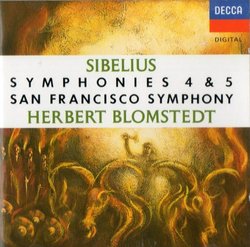| All Artists: Sibelius, Blomstedt, San Francisco Symphony Title: Symphonies 4 & 5 Members Wishing: 0 Total Copies: 0 Label: Polygram Records Release Date: 5/10/1991 Genre: Classical Styles: Historical Periods, Modern, 20th, & 21st Century, Symphonies Number of Discs: 1 SwapaCD Credits: 1 UPC: 028942585829 |
Search - Sibelius, Blomstedt, San Francisco Symphony :: Symphonies 4 & 5
 | Sibelius, Blomstedt, San Francisco Symphony Symphonies 4 & 5 Genre: Classical
|
Larger Image |
CD Details |
CD ReviewsMasterful Performances D. A Wend | Buffalo Grove, IL USA | 10/10/2008 (5 out of 5 stars) "I recently heard Sibelius' Fourth Symphony performed by the Chicago Symphony Orchestra under Michael Tilson Thomas which led me back to this memorable recording of the symphony by the San Francisco Symphony with their then music direct Herbert Blomstedt.
The Sibelius Fourth is the least popular of his symphonies but it has this dubious distinction not from any defect in the music itself but from the forward-looking aspect of the music: it remains today as problematic as it was when it was written almost 100 years ago. At the time he composed the Fourth, Jean Sibelius had several operations to remove a cancerous tumor from his throat. The music seems an expression of his anguish. The four movements are characterized by somber and grave melodies. Each of the movements ends as if Sibelius had just ceased writing. Even when a lighter tone is developed, as in the second vivace movement it is not true rejoicing and is quickly tempered by a return to the bleak, if not hostile, theme. The heart of the symphony is the slow movement where full expression is given to quiet despair, gradually building in volume to a climax with the full orchestra. The strings dominate the movement with the woodwinds and horns providing development. The Finale begins with a more joyous melody punctuated by a glockenspiel (but here tubular bells are used). After exploring a more heroic melody the music gradually returns to its former mood of bleakness and closes with the strings fading away. Herbert Blomstedt provides an even tempo for this performance with marvelous playing by the San Francisco Symphony. By contrast, Sir Thomas Beecham adopted much quicker tempi that tend to make the music seem a bit less bleak. The use of tubular bells was rather controversial when this CD appeared and their use does go against the score. It is interesting to hear them but they are a far heavier sound than Sibelius intended. The Fifth Symphony, with its heroic character, is the antithesis of the Fourth. Sibelius revised his original four movement concept down to three movements, with the scherzo integrated into the first movement. The symphony is one of the most engaging written. The second movement is a charming theme and variations with the theme announced by the flute. The energetic Finale is exhilarating and contains the "swan" melody that is played by the horns after the initial introduction. Sibelius was moved to write this music after watching a flock of swans in flight. This is a masterful performance by the San Francisco Symphony that is beautifully phrases and the recording is absolutely perfect. " |

 Track Listings (7) - Disc #1
Track Listings (7) - Disc #1